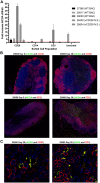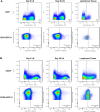Molecular analysis of lymphoid tissue from rhesus macaque rhadinovirus-infected monkeys identifies alterations in host genes associated with oncogenesis
- PMID: 32017809
- PMCID: PMC6999886
- DOI: 10.1371/journal.pone.0228484
Molecular analysis of lymphoid tissue from rhesus macaque rhadinovirus-infected monkeys identifies alterations in host genes associated with oncogenesis
Abstract
Rhesus macaque (RM) rhadinovirus (RRV) is a simian gamma-2 herpesvirus closely related to human Kaposi's sarcoma-associated herpesvirus (KSHV). RRV is associated with the development of diseases in simian immunodeficiency virus (SIV) co-infected RM that resemble KSHV-associated pathologies observed in HIV-infected humans, including B cell lymphoproliferative disorders (LPD) and lymphoma. Importantly, how de novo KSHV infection affects the expression of host genes in humans, and how these alterations in gene expression affect viral replication, latency, and disease is unknown. The utility of the RRV/RM infection model provides a novel approach to address these questions in vivo, and utilizing the RRV bacterial artificial chromosome (BAC) system, the effects of specific viral genes on host gene expression patterns can also be explored. To gain insight into the effects of RRV infection on global host gene expression patterns in vivo, and to simultaneously assess the contributions of the immune inhibitory viral CD200 (vCD200) molecule to host gene regulation, RNA-seq was performed on pre- and post-infection lymph node (LN) biopsy samples from RM infected with either BAC-derived WT (n = 4) or vCD200 mutant RRV (n = 4). A variety of genes were identified as being altered in LN tissue samples due to RRV infection, including cancer-associated genes activation-induced cytidine deaminase (AICDA), glypican-1 (GPC1), CX3C chemokine receptor 1 (CX3CR1), and Ras dexamethasone-induced 1 (RasD1). Further analyses also indicate that GPC1 may be associated with lymphomagenesis. Finally, comparison of infection groups identified the differential expression of host gene thioredoxin interacting protein (TXNIP), suggesting a possible mechanism by which vCD200 negatively affects RRV viral loads in vivo.
Conflict of interest statement
The authors have declared that no competing interests exist.
Figures







Similar articles
-
The rhesus rhadinovirus CD200 homologue affects immune responses and viral loads during in vivo infection.J Virol. 2014 Sep;88(18):10635-54. doi: 10.1128/JVI.01276-14. Epub 2014 Jul 2. J Virol. 2014. PMID: 24991004 Free PMC article.
-
Generation of chimeric forms of rhesus macaque rhadinovirus expressing KSHV envelope glycoproteins gH and gL for utilization in an NHP model of infection.J Virol. 2025 Feb 25;99(2):e0192324. doi: 10.1128/jvi.01923-24. Epub 2025 Jan 21. J Virol. 2025. PMID: 39835812 Free PMC article.
-
Membrane-associated and secreted forms of the Rhesus macaque rhadinovirus-encoded CD200 homologue and cellular CD200 demonstrate differential effects on Rhesus Macaque CD200 Receptor signaling and regulation of myeloid cell activation.J Virol. 2021 Mar 1;95(5):e01654-20. doi: 10.1128/JVI.01654-20. Epub 2020 Dec 16. J Virol. 2021. PMID: 33328302 Free PMC article.
-
Rhesus macaque rhadinovirus-associated disease.Curr Opin Virol. 2013 Jun;3(3):245-50. doi: 10.1016/j.coviro.2013.05.016. Epub 2013 Jun 6. Curr Opin Virol. 2013. PMID: 23747119 Free PMC article. Review.
-
Rhesus monkey rhadinovirus: a model for the study of KSHV.Curr Top Microbiol Immunol. 2007;312:43-69. doi: 10.1007/978-3-540-34344-8_2. Curr Top Microbiol Immunol. 2007. PMID: 17089793 Review.
Cited by
-
Research progress on the mechanism of exosome-mediated virus infection.Front Cell Infect Microbiol. 2024 Jun 26;14:1418168. doi: 10.3389/fcimb.2024.1418168. eCollection 2024. Front Cell Infect Microbiol. 2024. PMID: 38988816 Free PMC article. Review.
-
Horizontal transmission of endemic viruses among rhesus macaques (Macaca mulatta): Implications for human cytomegalovirus vaccine/challenge design.J Med Primatol. 2023 Feb;52(1):53-63. doi: 10.1111/jmp.12621. Epub 2022 Sep 23. J Med Primatol. 2023. PMID: 36151734 Free PMC article.
-
The Glycocalyx and Its Role in Vascular Physiology and Vascular Related Diseases.Cardiovasc Eng Technol. 2021 Feb;12(1):37-71. doi: 10.1007/s13239-020-00485-9. Epub 2020 Sep 21. Cardiovasc Eng Technol. 2021. PMID: 32959164 Free PMC article. Review.
-
Dynamic alterations in bacterial and fungal microbiome and inflammatory cytokines following SRV-8 infection in cynomolgus monkeys.Zool Res. 2025 Mar 18;46(2):325-338. doi: 10.24272/j.issn.2095-8137.2024.278. Zool Res. 2025. PMID: 40049661 Free PMC article.
References
-
- Wong SW, Bergquam EP, Swanson RM, Lee FW, Shiigi SM, Avery NA, et al. Induction of B cell hyperplasia in simian immunodeficiency virus-infected rhesus macaques with the simian homologue of Kaposi’s sarcoma-associated herpesvirus. J Exp Med. 1999;190(6):827–40. 10.1084/jem.190.6.827 . - DOI - PMC - PubMed
Publication types
MeSH terms
Substances
Grants and funding
LinkOut - more resources
Full Text Sources
Miscellaneous

